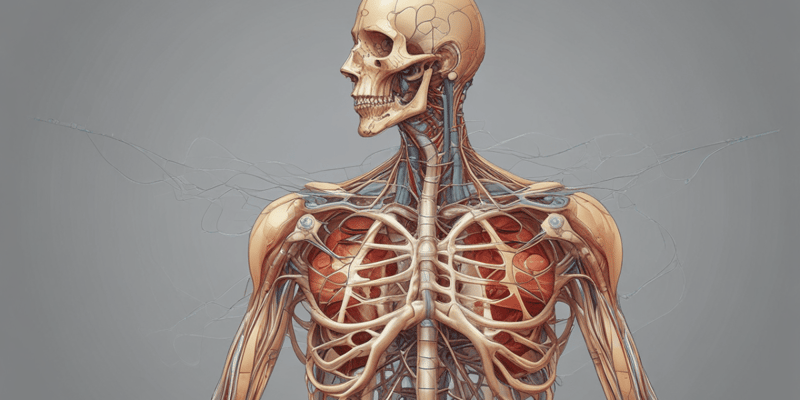Podcast Beta
Questions and Answers
Match the following structures with their descriptions in the lymphatic system:
Thoracic duct = Main duct for lymph drainage from the lower body Right lymphatic duct = Lymph drainage from the right upper quadrant Lymph nodes = Filter lymph and house immune cells Spleen = Filters blood and recycles iron
Match the following thoracic sympathetic nerves with their primary functions:
Greater thoracic splanchnic nerve = Preganglionic efferent and visceral afferent nerve fibers Lesser thoracic splanchnic nerve = Carries fibers to the adrenal gland Least thoracic splanchnic nerve = Supplies fibers to the renal plexus Intrathoracic nerve of Kuntz = Carries sympathetic fibers to the brachial plexus
Match the vagus nerve functions with their roles:
Preganglionic parasympathetic innervation = Regulates heart rate and digestion Motor to the circular non-striated muscle = Controls muscle function in the gastrointestinal system Sensory from thoracic and abdominal viscera = Transmits sensory information back to the brain Secretomotor to mucous glands = Stimulates secretion in the respiratory tract
Match the following thoracic structures with their anatomical locations:
Signup and view all the answers
Match the following functions of the vagus nerve with their descriptions:
Signup and view all the answers
Match the following thoracic splanchnic nerves with their target organs:
Signup and view all the answers
Match the following anatomical features with their characteristics:
Signup and view all the answers
Match the following structures with their locations or functions:
Signup and view all the answers
Match the following symptoms with their associated conditions:
Signup and view all the answers
Match the following descriptions with their medical conditions:
Signup and view all the answers
Match the following factors with their correlation to oesophagus length in children:
Signup and view all the answers
Match the following nervous structures with their functions or locations:
Signup and view all the answers
Match the following components with their relevant characteristics:
Signup and view all the answers
Match the surgical approaches with their potential outcome regarding the thoracic duct:
Signup and view all the answers
Match the tributaries of the right lymphatic trunk with their identity:
Signup and view all the answers
Match the length of the right lymphatic trunk with its frequency in individuals:
Signup and view all the answers
Match the ganglion with its common association:
Signup and view all the answers
Match the structures that conceal the terminal portions of the right lymphatic trunk:
Signup and view all the answers
Match the functions of the vagus nerve with their corresponding effects:
Signup and view all the answers
Match the anatomical features associated with the scalene fat pad:
Signup and view all the answers
Match the thoracic sympathetic nerves with their general functions:
Signup and view all the answers
Match the clinical aspects of the thoracic duct with their implications:
Signup and view all the answers
Study Notes
Cervical Thoracic Ganglion
- The first thoracic ganglion almost always fuses with the inferior cervical ganglion, forming the cervicothoracic (stellate) ganglion.
Greater Thoracic Splanchnic Nerve
- The greater thoracic splanchnic nerve is primarily composed of myelinated preganglionic efferent and visceral afferent nerve fibers.
Intrathoracic Nerve of Kuntz
- The intrathoracic nerve of Kuntz is thought to carry sympathetic nerve fibers to the brachial plexus without passing through the sympathetic trunk.
Vagus Nerve in Mediastinum
- The vagus nerve contains preganglionic parasympathetic nerve fibers which travel in its branches and synapse in minute ganglia in the visceral walls.
Right Vagus Nerve
- The right vagus nerve descends posterior to the right internal jugular vein in the neck and crosses anterior to the first part of the right subclavian artery to enter the thorax.
Chyle
- Chyle is rich in lipid, protein, T lymphocytes, immunoglobulins, and fat-soluble vitamins, with chylomicrons being a primary component.
Surgical Approach and Thoracic Duct
- The left cervical approach for exposing the vertebral and subclavian arteries or the cervico-thoracic sympathetic ganglion may lead to thoracic duct injury.
- Deliberate ligation of the duct at this level is an accepted surgical maneuver.
Right Lymphatic Trunk
- The three main tributaries of the right lymphatic trunk are the right jugular, subclavian, and bronchomediastinal trunks.
- These often empty separately into either the right internal jugular and/or subclavian veins.
- In up to 20% of individuals, the right lymphatic trunk may aggregate to form a structure that is usually 5-10 mm in length.
Terminal Portions of Right Lymphatic Trunk and Thoracic Duct
- The terminal portions of the right lymphatic trunk and the thoracic duct are concealed by the scalene fat pad, making them more vulnerable during surgery.
First Thoracic Ganglion
- The first thoracic ganglion is almost always fused with the inferior cervical ganglion.
Thymic Tumors
- Thymic tumors may compress the trachea, esophagus, and large veins in the neck.
- This can cause hoarseness, cough, dysphagia, and venous engorgement of the head and neck.
Myasthenia Gravis
- Myasthenia gravis presents as a diminution in power of repetitive contraction in certain voluntary muscles, due to autoantibodies attacking acetylcholine receptor proteins at neuromuscular junctions.
Oesophagus Length in Children
- The length of the oesophagus in children is best correlated with height.
Cervical Portion of Oesophagus
- The cervical portion of the oesophagus is located posterior to the trachea, to which it is attached by loose connective tissue.
Recurrent Laryngeal Nerves
- The recurrent laryngeal nerves ascend on each side in or near the tracheo-oesophageal groove.
Common Carotid Artery
- The common carotid artery is located laterally to the cervical oesophagus.
Studying That Suits You
Use AI to generate personalized quizzes and flashcards to suit your learning preferences.
Related Documents
Description
Test your knowledge on the anatomy and functions of key thoracic nerves and ganglia. This quiz covers the cervicothoracic ganglion, greater thoracic splanchnic nerve, and more. Perfect for students of anatomy and physiology!




